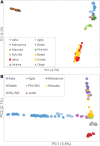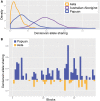Discerning the Origins of the Negritos, First Sundaland People: Deep Divergence and Archaic Admixture
- PMID: 28854687
- PMCID: PMC5597900
- DOI: 10.1093/gbe/evx118
Discerning the Origins of the Negritos, First Sundaland People: Deep Divergence and Archaic Admixture
Abstract
Human presence in Southeast Asia dates back to at least 40,000 years ago, when the current islands formed a continental shelf called Sundaland. In the Philippine Islands, Peninsular Malaysia, and Andaman Islands, there exist indigenous groups collectively called Negritos whose ancestry can be traced to the "First Sundaland People." To understand the relationship between these Negrito groups and their demographic histories, we generated genome-wide single nucleotide polymorphism data in the Philippine Negritos and compared them with existing data from other populations. Phylogenetic tree analyses show that Negritos are basal to other East and Southeast Asians, and that they diverged from West Eurasians at least 38,000 years ago. We also found relatively high traces of Denisovan admixture in the Philippine Negritos, but not in the Malaysian and Andamanese groups, suggesting independent introgression and/or parallel losses involving Denisovan introgressed regions. Shared genetic loci between all three Negrito groups could be related to skin pigmentation, height, facial morphology and malarial resistance. These results show the unique status of Negrito groups as descended from the First Sundaland People.
Keywords: Denisovan; Negritos; Southeast Asia; admixture; population genetics.
© The Author(s) 2017. Published by Oxford University Press on behalf of the Society for Molecular Biology and Evolution.
Figures





Similar articles
-
Genetic diversity and evidence for population admixture in Batak Negritos from Palawan.Am J Phys Anthropol. 2011 Sep;146(1):62-72. doi: 10.1002/ajpa.21544. Am J Phys Anthropol. 2011. PMID: 21796613
-
The population genomic landscape of human genetic structure, admixture history and local adaptation in Peninsular Malaysia.Hum Genet. 2014 Sep;133(9):1169-85. doi: 10.1007/s00439-014-1459-8. Epub 2014 Jun 11. Hum Genet. 2014. PMID: 24916469
-
Admixture patterns and genetic differentiation in negrito groups from West Malaysia estimated from genome-wide SNP data.Hum Biol. 2013 Feb-Jun;85(1-3):173-88. doi: 10.3378/027.085.0308. Hum Biol. 2013. PMID: 24297225
-
Terror from the sky: unconventional linguistic clues to the negrito past.Hum Biol. 2013 Feb-Jun;85(1-3):401-16. doi: 10.3378/027.085.0319. Hum Biol. 2013. PMID: 24297235 Review.
-
The genetic history of Peninsular Malaysia.Gene. 2016 Jul 15;586(1):129-35. doi: 10.1016/j.gene.2016.04.008. Epub 2016 Apr 7. Gene. 2016. PMID: 27060406 Review.
Cited by
-
A genotype imputation reference panel specific for native Southeast Asian populations.NPJ Genom Med. 2024 Oct 5;9(1):47. doi: 10.1038/s41525-024-00435-7. NPJ Genom Med. 2024. PMID: 39368969 Free PMC article.
-
Hunter-gatherer genetics research: Importance and avenues.Evol Hum Sci. 2024 Feb 15;6:e15. doi: 10.1017/ehs.2024.7. eCollection 2024. Evol Hum Sci. 2024. PMID: 38516374 Free PMC article.
-
More than a decade of genetic research on the Denisovans.Nat Rev Genet. 2024 Feb;25(2):83-103. doi: 10.1038/s41576-023-00643-4. Epub 2023 Sep 18. Nat Rev Genet. 2024. PMID: 37723347 Review.
-
Munda languages are father tongues, but Japanese and Korean are not.Evol Hum Sci. 2020 May 29;2:e19. doi: 10.1017/ehs.2020.14. eCollection 2020. Evol Hum Sci. 2020. PMID: 37588351 Free PMC article. Review.
-
Prehistoric human migration between Sundaland and South Asia was driven by sea-level rise.Commun Biol. 2023 Feb 4;6(1):150. doi: 10.1038/s42003-023-04510-0. Commun Biol. 2023. PMID: 36739308 Free PMC article.
References
-
- Barker G, et al.2007. The ‘human revolution’ in lowland tropical Southeast Asia: the antiquity and behavior of anatomically modern humans at Niah Cave (Sarawak, Borneo). J Hum Evol. 52:243–261. - PubMed
-
- Barrows DP. 1910. The Negrito and allied types in the Philippines. Am Anthropol. 12:358–376.
MeSH terms
LinkOut - more resources
Full Text Sources
Other Literature Sources


